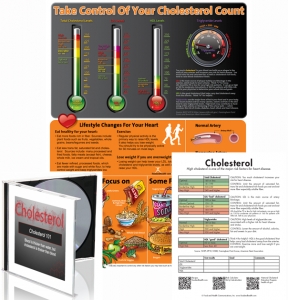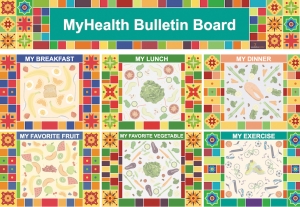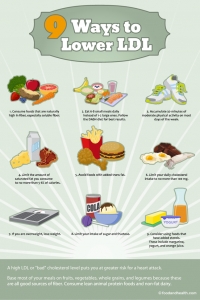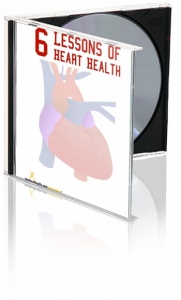Take Control of Your Cholesterol Levels
It's time to help your clients take control of their cholesterol levels. Let's get right down to it!What is Cholesterol?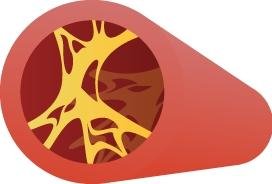 Cholesterol is a waxy substance that is very similar to fat. Your body needs it in order to make hormones and digest the food you eat. That said, your body can actually make all the cholesterol that it needs in order to carry out these tasks.Some substances, like saturated fats, prompt your body to make more cholesterol than it needs. Plus, you can also eat foods that contain dietary cholesterol.Cholesterol travels through your blood in packets of protein and fat. These packets are called lipoproteins, and there are two types of lipoprotein packets:
Cholesterol is a waxy substance that is very similar to fat. Your body needs it in order to make hormones and digest the food you eat. That said, your body can actually make all the cholesterol that it needs in order to carry out these tasks.Some substances, like saturated fats, prompt your body to make more cholesterol than it needs. Plus, you can also eat foods that contain dietary cholesterol.Cholesterol travels through your blood in packets of protein and fat. These packets are called lipoproteins, and there are two types of lipoprotein packets:
- Low-density lipoproteins are also called LDL or "bad" cholesterol. These pile up and stick to your artery walls, which makes it harder for your circulatory system to work as it should.
- High-density lipoproteins are also called HDL or "good" cholesterol. These move cholesterol from your bloodstream to your liver, where it can be processed out of your body.
When you have too much cholesterol in your blood, it's called high cholesterol. This is not good for your health.Let's find out why.Why Should I Control My Cholesterol Levels? Too much cholesterol in your body can lead to all kinds of health issues. According to the National Heart, Lung, and Blood Institute (NHLBI), "People who have high blood cholesterol have a greater chance of getting coronary heart disease [...] The higher the level of LDL cholesterol in your blood, the GREATER your chance is of getting heart disease."This is because cholesterol can contribute the the buildup of plaque in your arteries, which in turn can harden their walls and clog the flow of blood. Or the plaque can rip open, sending blood clots into your bloodstream. Once that happens, your risk of heart attack, angina, and stroke all go through the roof.But there's good news!The NHLBI asserts "Lowering your cholesterol may slow, reduce, or even stop the buildup of plaque in your arteries. It also may reduce the risk of plaque rupturing and causing dangerous blood clots."How Can I Control My Cholesterol Levels?
Too much cholesterol in your body can lead to all kinds of health issues. According to the National Heart, Lung, and Blood Institute (NHLBI), "People who have high blood cholesterol have a greater chance of getting coronary heart disease [...] The higher the level of LDL cholesterol in your blood, the GREATER your chance is of getting heart disease."This is because cholesterol can contribute the the buildup of plaque in your arteries, which in turn can harden their walls and clog the flow of blood. Or the plaque can rip open, sending blood clots into your bloodstream. Once that happens, your risk of heart attack, angina, and stroke all go through the roof.But there's good news!The NHLBI asserts "Lowering your cholesterol may slow, reduce, or even stop the buildup of plaque in your arteries. It also may reduce the risk of plaque rupturing and causing dangerous blood clots."How Can I Control My Cholesterol Levels? Lifestyle changes are a great way to bring your cholesterol levels under control. These kinds of changes fall into two categories.
Lifestyle changes are a great way to bring your cholesterol levels under control. These kinds of changes fall into two categories.
- Diet
- Exercise
The National Institute of Health has revealed that "You can lower your cholesterol by exercising more and eating more fruits and vegetables." Let's take a look at each piece of the puzzle.Diet is a key factor. Why? Well, as mentioned above, what you eat really affects how much cholesterol your body produces. According to the Department of Health and Human Services, "Saturated fat raises your LDL cholesterol level more than anything else in your diet. Diets with too much saturated fat, trans fat, and cholesterol are the main cause for high levels of blood cholesterol—a leading contributor to the high rate of heart attacks among Americans."With that in mind, it makes sense that you should reduce the saturated fat in your diet, along with trans fat and dietary cholesterol. Now let's move on to the fun part. What should you replace those foods with?When your recipe calls for a bit of fat, try unsaturated fats instead. These are far better for your heart, and they don't contain the elements that make solid fats so bad for your cholesterol levels. Try avocado, olive oil, nuts and seeds, canola oil, fatty fish, etc.It's also wise to increase the amount of fiber you eat each day. Many studies have found support for a link between fiber and heart health, including the study Effects of soluble dietary fiber on low-density lipoprotein cholesterol and coronary heart disease risk. Its author asserts "Strong epidemiologic and experimental data suggest that increasing dietary fiber may help to lower low-density lipoprotein cholesterol (LDL-C) and decrease the risk of coronary heart disease."Phew! That was a lot about diet. Now it's time to talk about exercise.
Now let's move on to the fun part. What should you replace those foods with?When your recipe calls for a bit of fat, try unsaturated fats instead. These are far better for your heart, and they don't contain the elements that make solid fats so bad for your cholesterol levels. Try avocado, olive oil, nuts and seeds, canola oil, fatty fish, etc.It's also wise to increase the amount of fiber you eat each day. Many studies have found support for a link between fiber and heart health, including the study Effects of soluble dietary fiber on low-density lipoprotein cholesterol and coronary heart disease risk. Its author asserts "Strong epidemiologic and experimental data suggest that increasing dietary fiber may help to lower low-density lipoprotein cholesterol (LDL-C) and decrease the risk of coronary heart disease."Phew! That was a lot about diet. Now it's time to talk about exercise.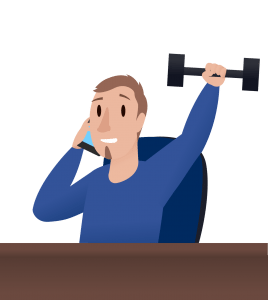 The Centers for Disease Control and Prevention maintain, "Physical activity can help maintain a healthy weight and lower cholesterol. The Surgeon General recommends adults engage in moderate-intensity exercise for 2 hours and 30 minutes every week."There is a ton of research that supports this assertion. Let's zoom in on one recent study, Effects of exercise, dietary cholesterol, and dietary fat on blood lipids. According to the authors of this study, "Exercise, a low fat diet, or a diet low in saturated fat content can each lower plasma total cholesterol and low-density lipoprotein (LDL) cholesterol." Remember, LDL cholesterol is the "bad" cholesterol that you should try to reduce.Talk with your doctor about what exercise plan will work for you. Remember to start slowly and keep steady!Where Can I Find More Information about Cholesterol?There are so many great resources to help you learn about cholesterol. Here are some of the most popular guides from Food and Health Communications, Inc.
The Centers for Disease Control and Prevention maintain, "Physical activity can help maintain a healthy weight and lower cholesterol. The Surgeon General recommends adults engage in moderate-intensity exercise for 2 hours and 30 minutes every week."There is a ton of research that supports this assertion. Let's zoom in on one recent study, Effects of exercise, dietary cholesterol, and dietary fat on blood lipids. According to the authors of this study, "Exercise, a low fat diet, or a diet low in saturated fat content can each lower plasma total cholesterol and low-density lipoprotein (LDL) cholesterol." Remember, LDL cholesterol is the "bad" cholesterol that you should try to reduce.Talk with your doctor about what exercise plan will work for you. Remember to start slowly and keep steady!Where Can I Find More Information about Cholesterol?There are so many great resources to help you learn about cholesterol. Here are some of the most popular guides from Food and Health Communications, Inc.
- Cholesterol 101
- 3 Facts for Cholesterol Month
- Activity Idea: Cholesterol Hallway
- Heart Disease Risk Factors
- New Cardiovascular Disease Prevention Guidelines
And here are more resources from around the web!
- Introduction to Cholesterol -- National Institute of Health
- Learn About Cholesterol -- Centers for Disease Control and Prevention
- Fast Stats: Cholesterol -- Centers for Disease Control and Prevention
- High Blood Cholesterol: What You Need to Know -- National Heart, Lung, and Blood Institute
- Cholesterol Education Resources -- American Heart Association
What do you think? Is this a useful guide for your clients? If you like what you see, don't miss the free handout that features the highlights of this post! Get your copy today!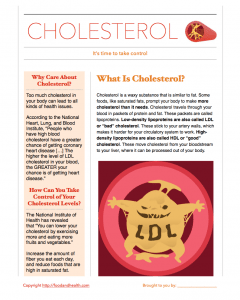 The fun continues with great heart education resources in the Nutrition Education Store. Which will you try?
The fun continues with great heart education resources in the Nutrition Education Store. Which will you try?